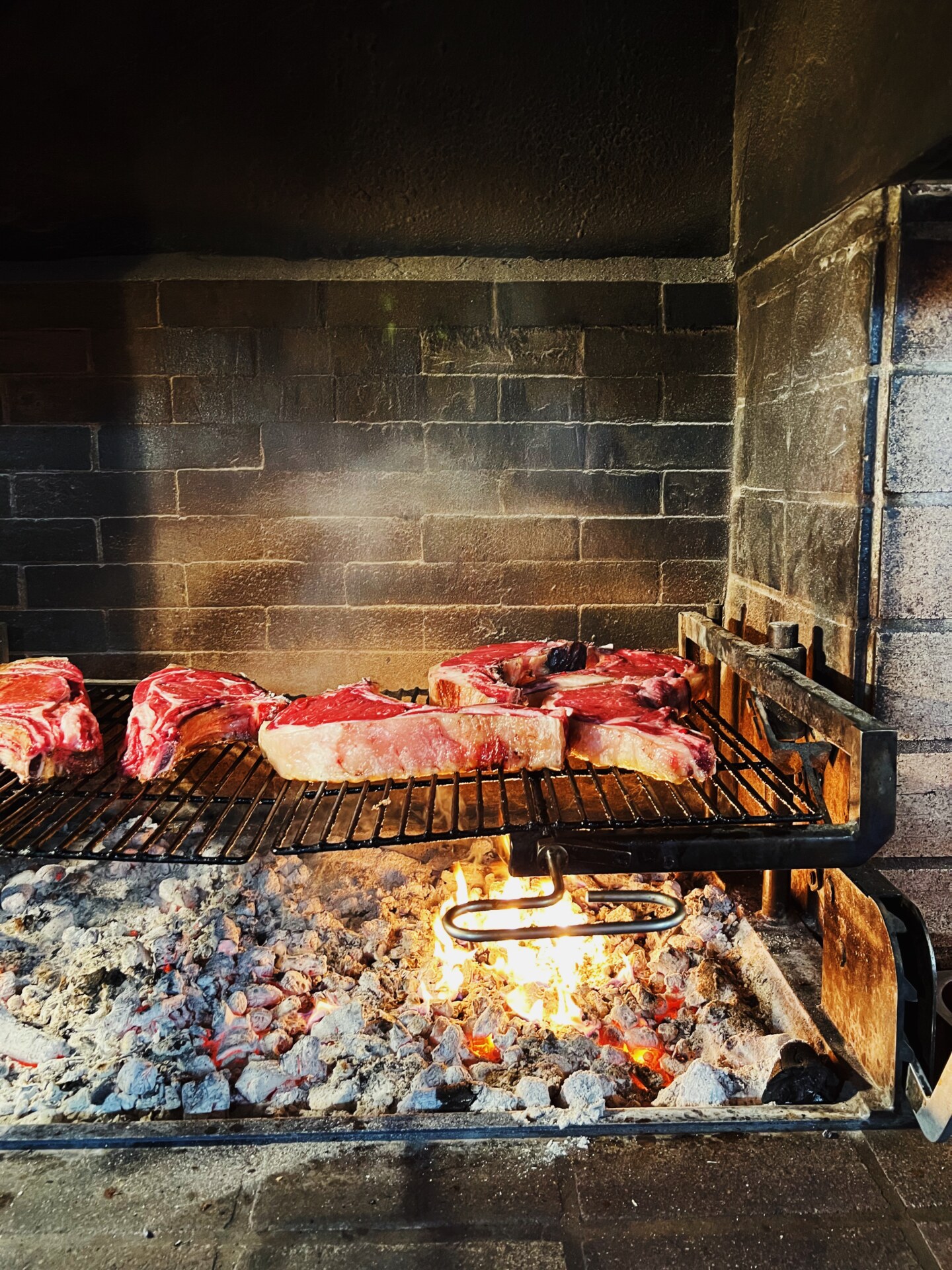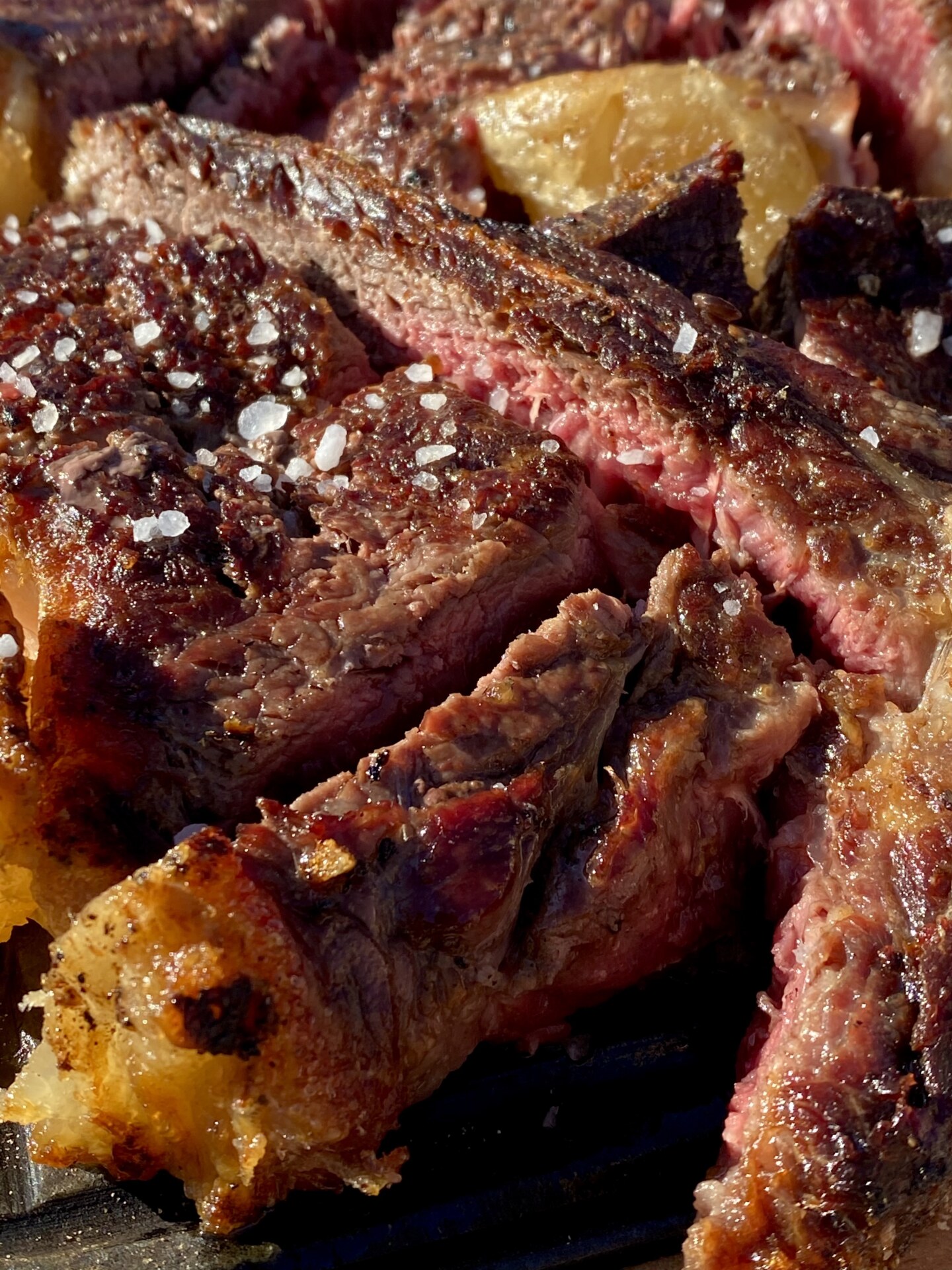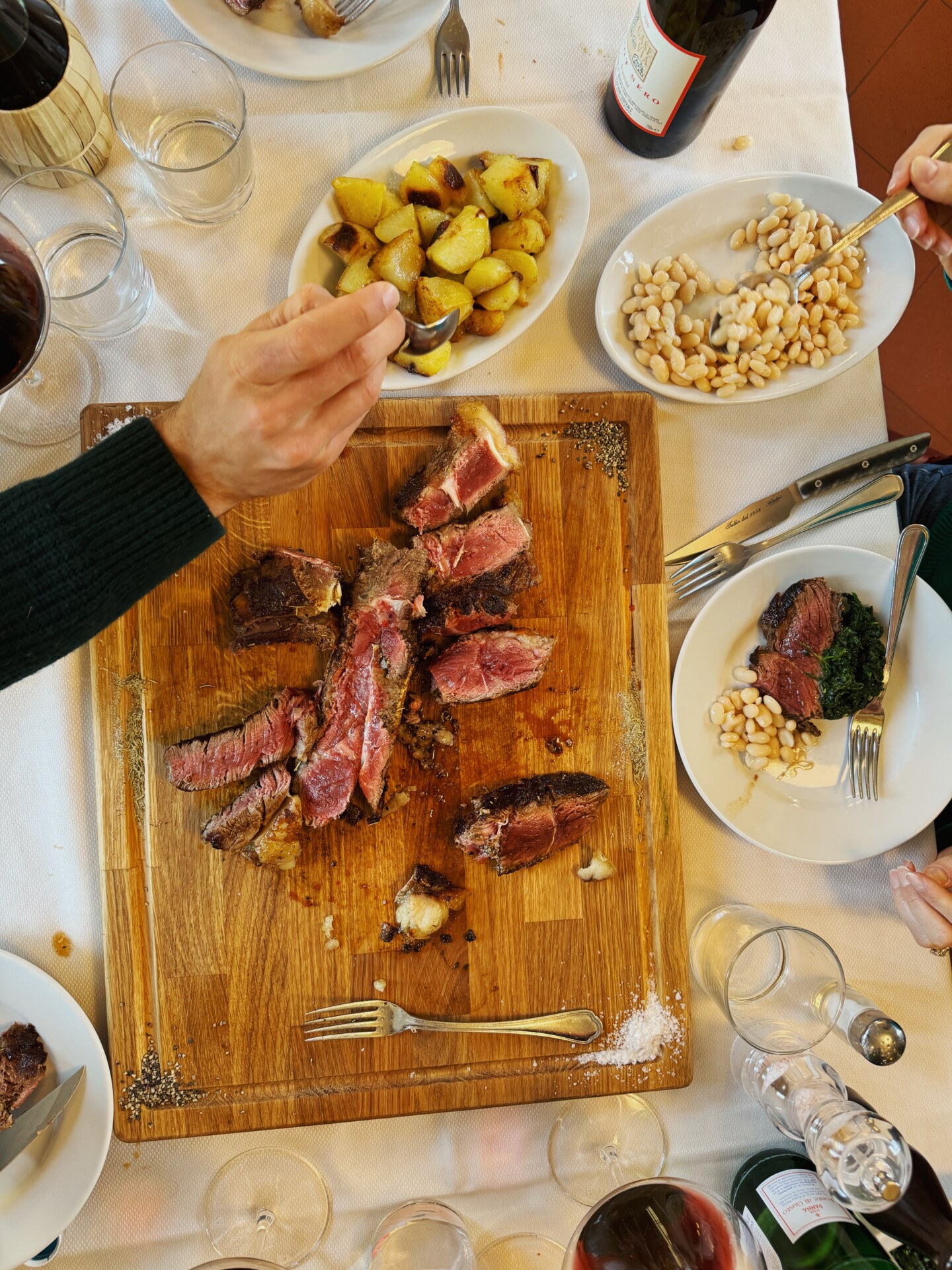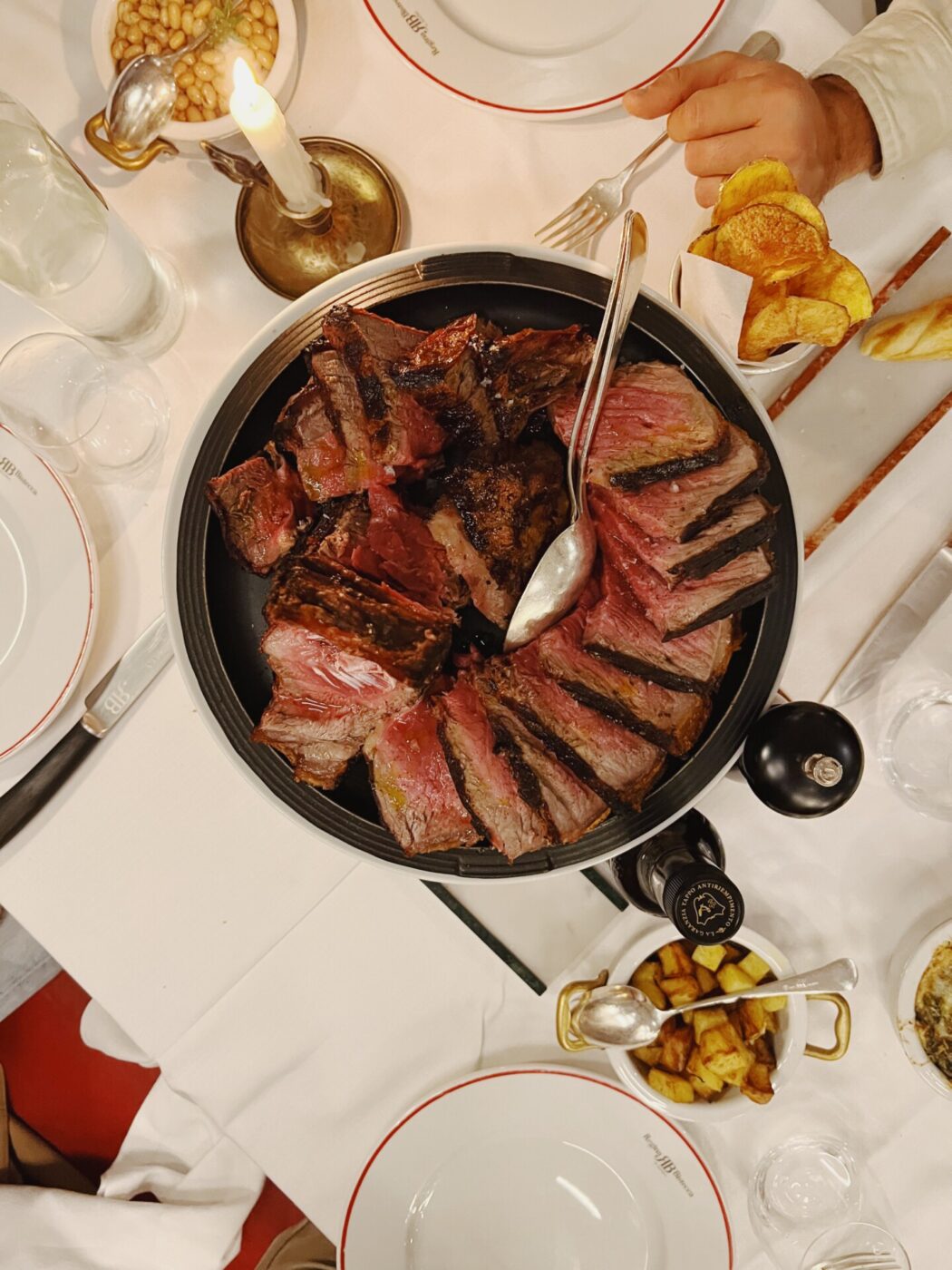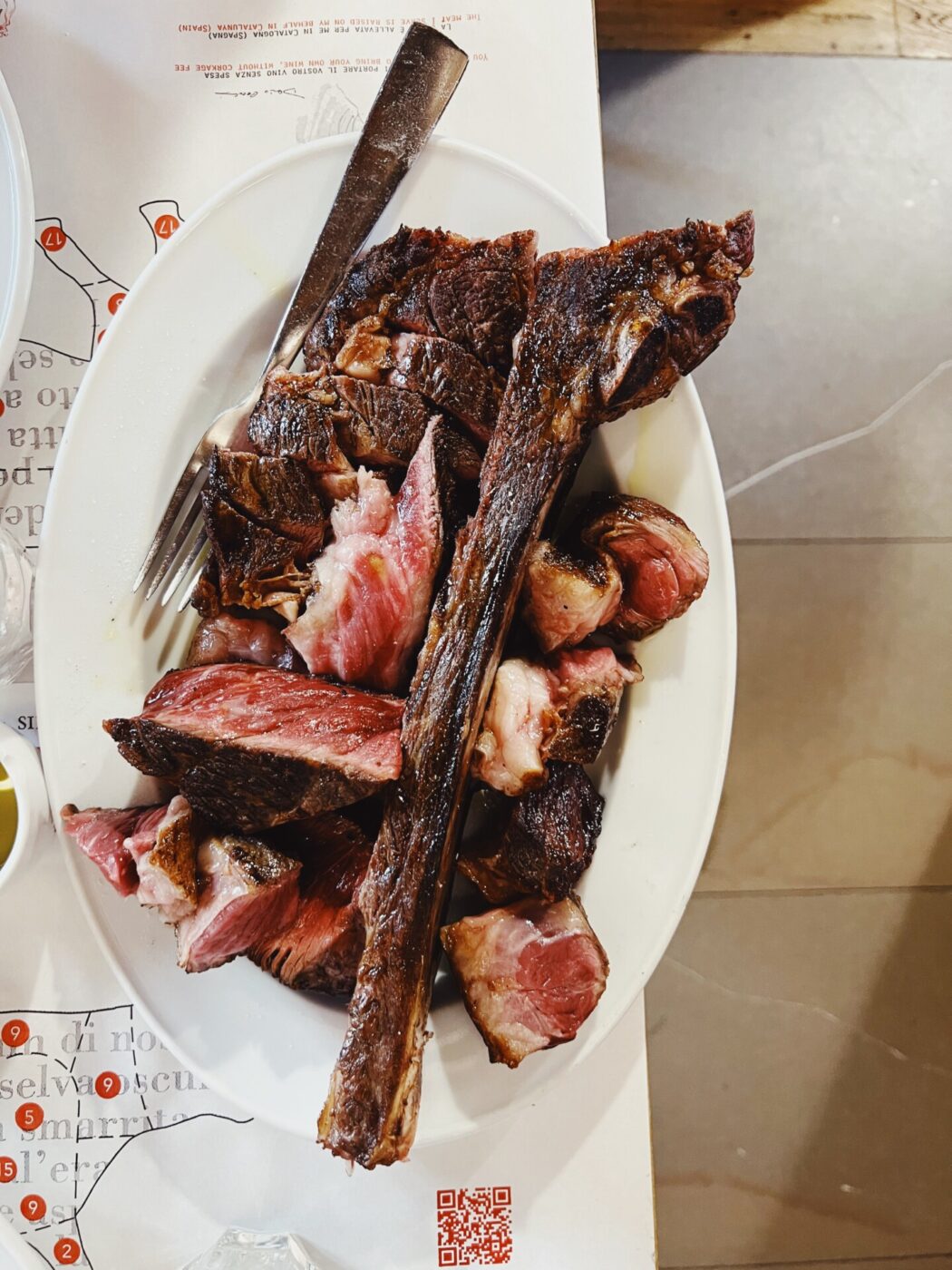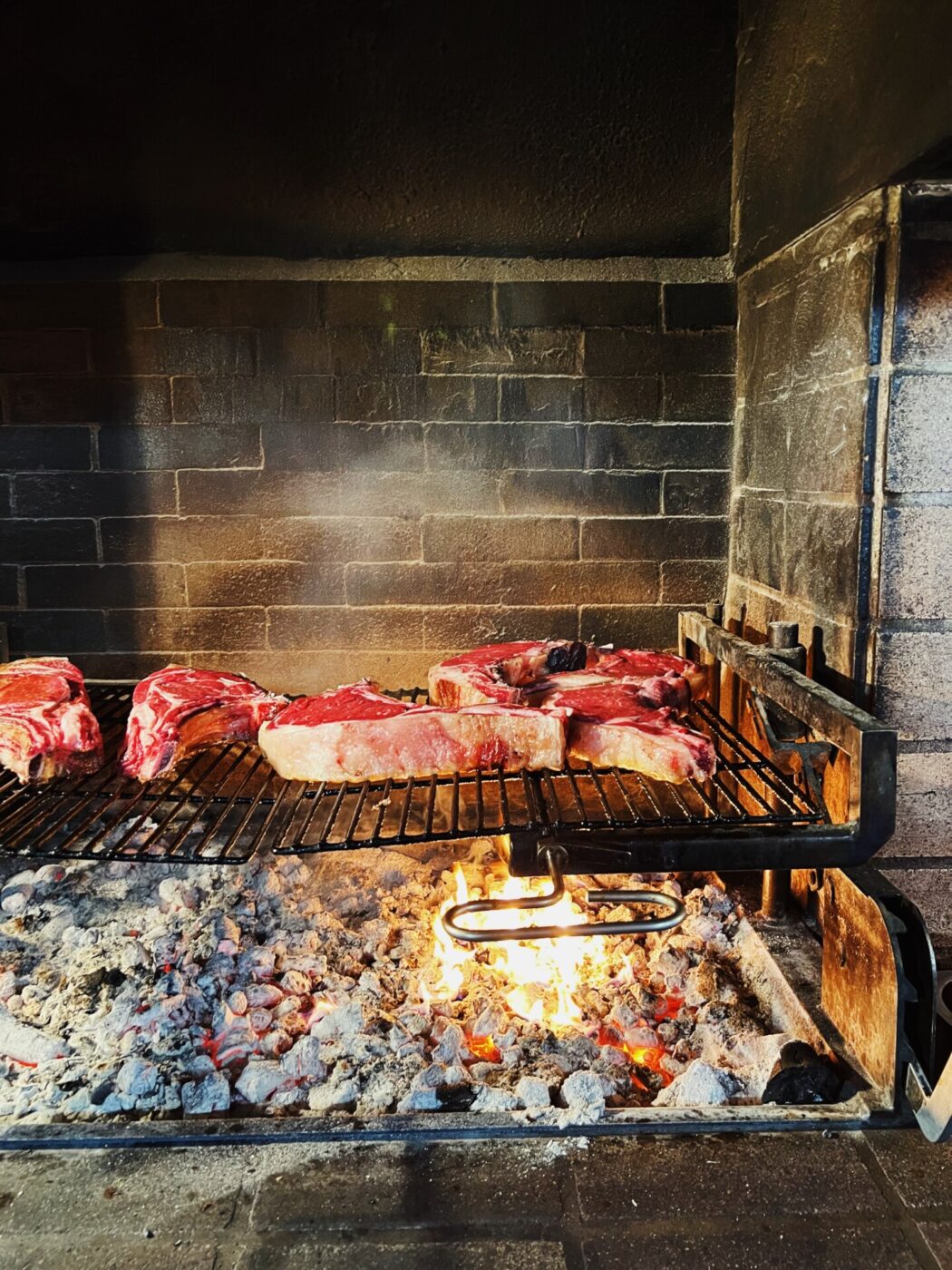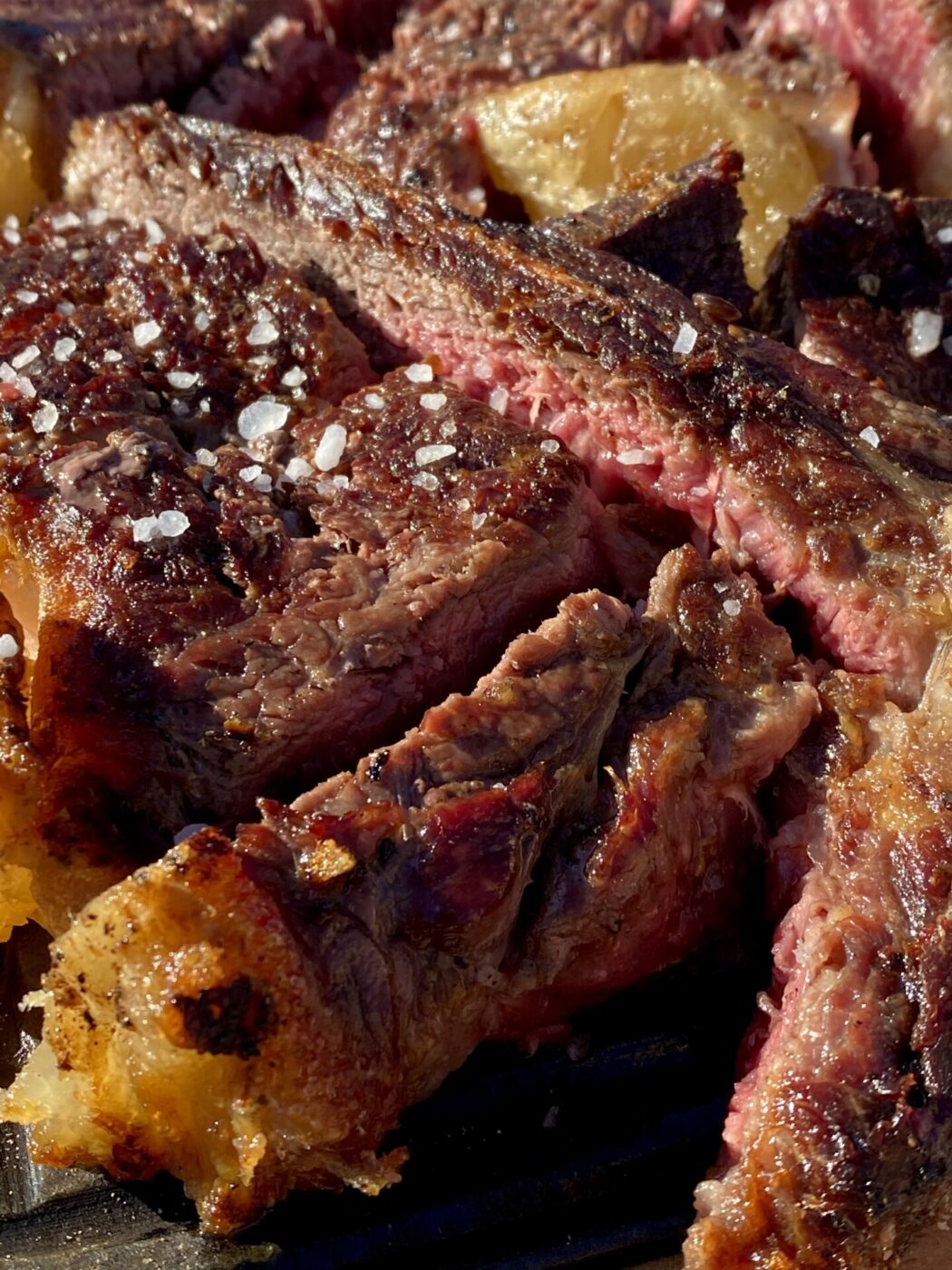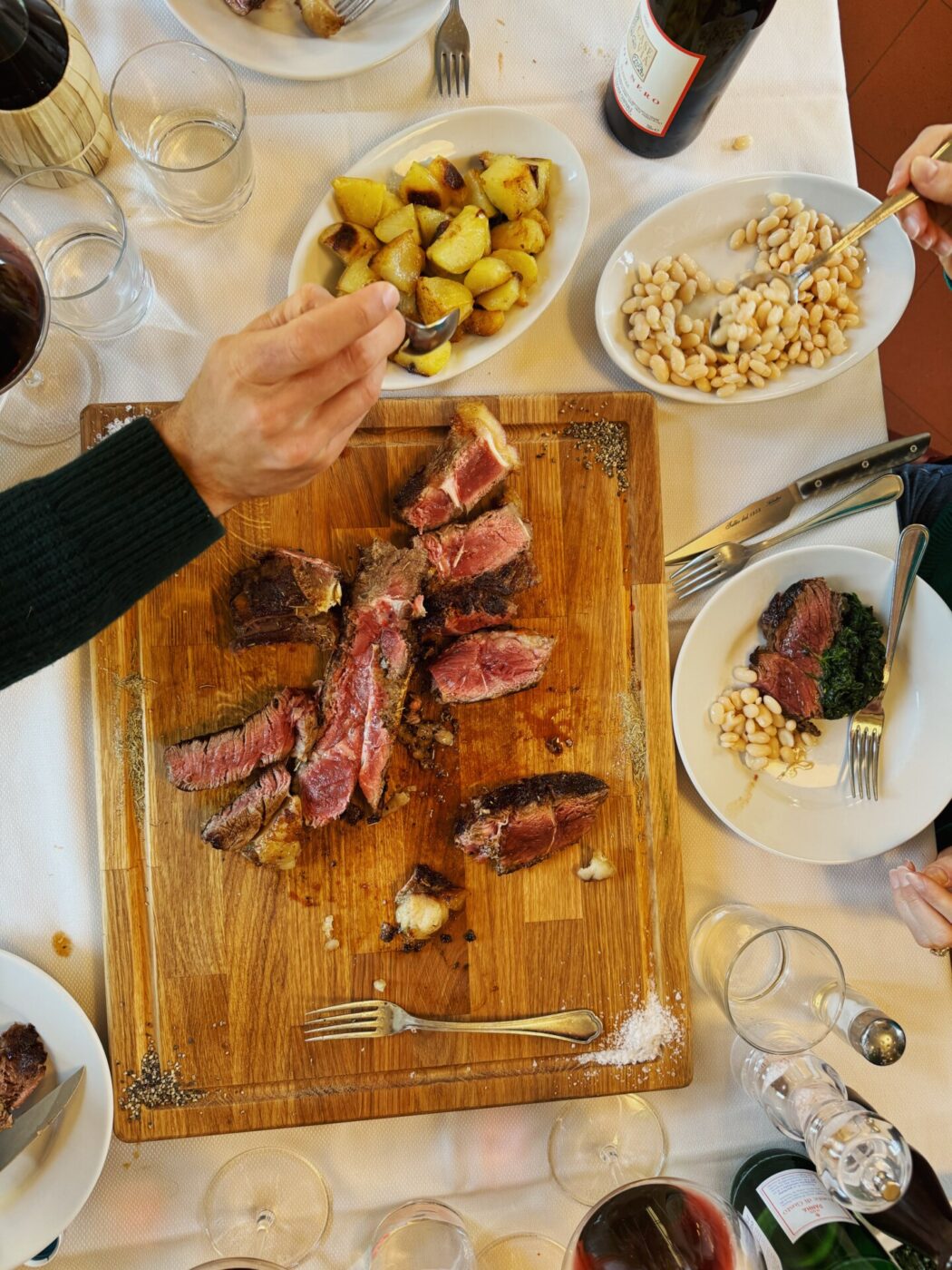Florence: home to hunky Calcio Storico players and even hunkier steaks. Though you can only find the former in June, the latter, better known as la bistecca alla Fiorentina, is dished up year-round at the city’s wealth of restaurants and grills. One of Florence’s most famous dishes, the bistecca alla Fiorentina dates back to March 23rd, 1565, when, in honor of Isabella Romola de’ Medici and Paolo Orsino’s wedding, the lords of the city grilled and served large quantities of fine cuts of meat to Florentine citizens. At the celebrations, visiting English knights started loudly cheering for the “beef steak” (this feels very in character for Brits), which turned into the Italian “bistecca”. “It’s one of few Italian words that doesn’t come from Latin,” Matteo Perduca–restaurateur of Regina Bistecca and hotelier behind boutique stays Stella D’Italia and Oltrarno Splendid–tells us.
So, how can you tell a good bistecca alla Fiorentina from a bad one? Renowned butcher and Chef’s Table favorite Dario Cecchini tells us, “Trust a good butcher, look him in the eyes, and if you see passion, heart, surely the steak will be good.” Hyperspecific traditionalists, however, will say there’s a few rules to live by:
- The cow: Purists will swear by the Chianina, a large white cattle breed that takes its name from its homeland, the Val di Chiana, which spans provinces in Tuscany and Umbria.
- The cut: The classic cut is the loin of a vitellone, or young male cow. The bone is T-shaped, with filet on one side and sirloin on the other and the fat still on. The meat should be well-aged, “a minimum of 21 days,” Perduca says.
- The cook: The meat should be cooked over the hot coals of a wood fire, Cecchini and Domenico, of Da Tullio, confirm–essential for the steak’s flavor.
- The height: The steak should be 3-4 cm high, or “four fingers” high. There’s a saying that anything under this is not a steak, but a carpaccio.
- The weight: A general rule of thumb is half a kilo per person, though this, of course, depends on how much other food you’re ordering and how much steak you can take down. The euros can rack up quickly, so we recommend asking how much the steak weighs before confirming the order.
- The seasonings: Traditionalists will say the steak should absolutely not be seasoned prior to cooking. Salt, pepper, and sometimes a drizzle of olive oil are to be added once the meat is cooked.
- The rareness: The perfect steak is well browned on the outside, but rare, and a bit bloody, on the inside. To do so, Cecchini tells us that it’s important that the meat “not be cold from the refrigerator.” (If you’re looking for a contender that’s more lax on this detail, read up on Regina Bistecca below.)
*There’s one restaurant, however, that dares to break more than one of these rules–and it’s beloved by even the most Florentine Florentines. Find it in the list below!
On the latter point, you’re advised to never ask for the steak to be cooked more–a grave faux pas that many Americans are known to commit. And, from a culinary perspective, you’re better off going the Florentine way. “American meat is usually very tender and has no problem being cooked more,” Perduca explains. “Italian meat, thanks to a different ‘diet’ and slower growth rate, doesn’t need to be cooked too long and is more tender and juicy when rare.”
Here, our eight favorite places, four in the city center and four on the outskirts, for a Florentine steak–some which live and die by the books, and some that bend the rules for no-less-mouthwatering results.
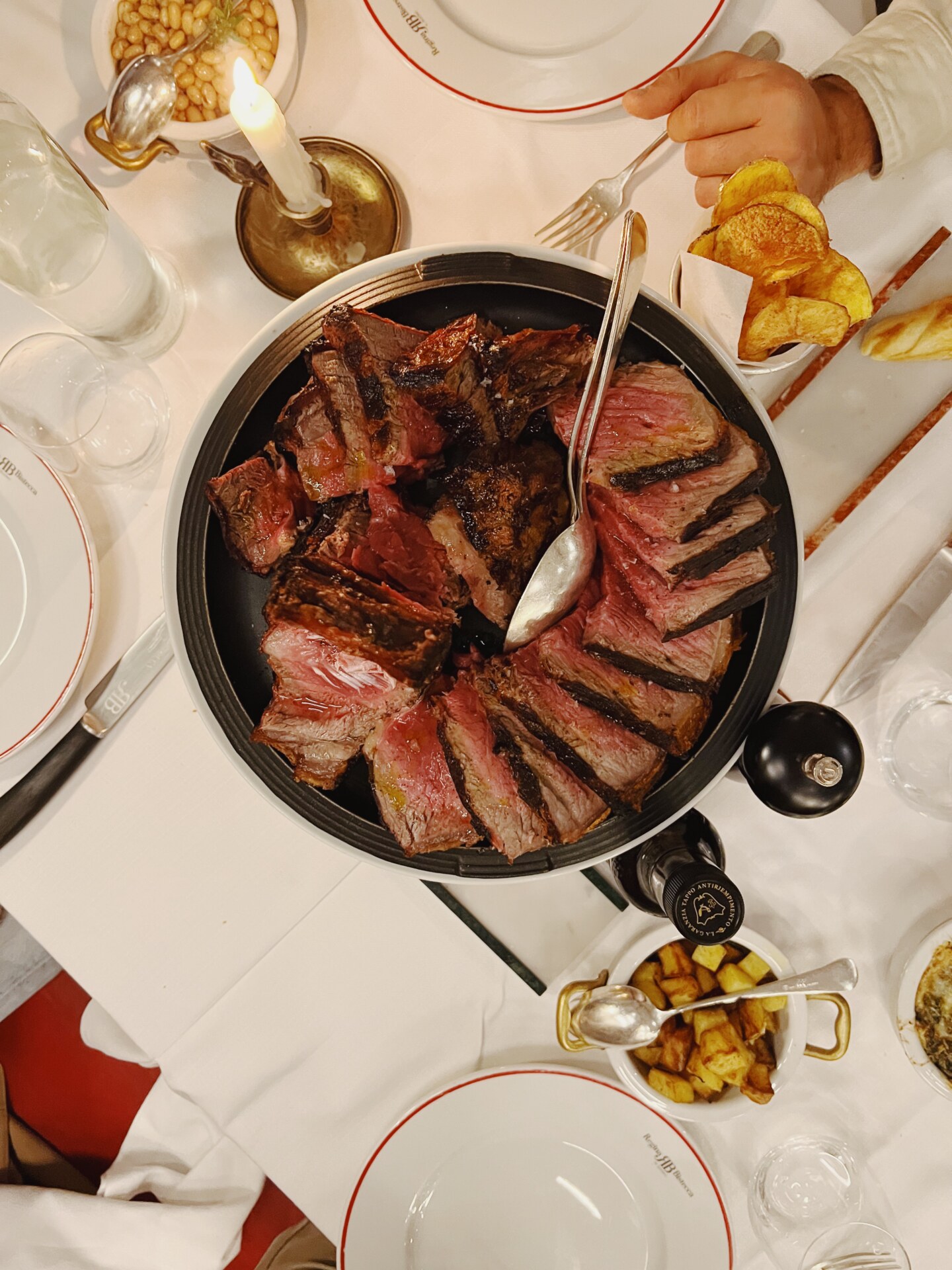
Regina Bistecca
WHERE TO EAT BISTECCA ALLA FIORENTINA IN CITY CENTER
Regina Bistecca
On the more upscale side, Regina Bistecca, from restaurateur and hotelier Matteo Perduca, is the place to go if you want to nerd out about steak (and, upon ordering your tenth here, you’re awarded an engraved knife!). Years of research and attention to detail makes his one of the best in the city center. “Always in search of the ‘perfect Fiorentina’, we have learned to choose a well-marbled meat that is aged from 21 days to 50. We cut it to a minimum of four centimeters thick and cook it in our JOSPER with vegetable charcoal,” Perduca illuminates. “We have learned to let the bistecca rest at 51°C for five minutes because it helps retain the extreme juiciness of the meat. We love to add some Maldon salt for extra crunchiness and a few drops of top-quality extra virgin olive oil. Pepper to taste.” There are three different breeds of cattle on the menu, including the classic Chianina, which comes from Val di Chiana farm Tenuta San Giobbe.
Though many Florentines will be shocked to hear it, Perduca, a Florentine himself, tells us, “I don’t also find it a ‘crime’ to cook it a little bit more. Tastes are tastes.” Perduca explains that his customers from the US are the ones most likely to ask for a Fiorentina cooked medium/well done, and, considering the type of meat common in the US, it’s a valid request.
Buca Lapi
One of the most historic addresses for bistecca alla Fiorentina–the place has been open since 1880–Buca Lapi is certainly no secret; you’re going to want to book ahead. You better bet that to be a fan favorite for over 140 years, the steak is top-notch. For those of you who like it bloody, you’re in luck; for those who don’t… this is not the place to ask for it to be cooked more. Buca Lapi is a member of the classical canon, through and through. Sit in the main room with all the posters on the vaulted ceilings, and make sure to check the weight of the steak before confirming–this one comes with a hefty price tag.
Ristorante Fagioli
You won’t find this Santa Croce neighborhood spot on any other list–and that’s why we love it. You can almost always get a same-day table (please don’t ruin this for us!), and the bistecca alla Fiorentina, made with Chianina, is well-priced and excellent–nice and crusty on the edges with a good amount of salt. Eyeball what’s cooking in the open kitchen as you walk in, and don’t miss ordering something off the primi section too (we say go for the penne strascicate, if they have it).
Il Latini
Another historic address for bistecca alla Fiorentina, Il Latini is no secret–but they’ve gained their reputation for good reason. The steak here gets the most perfect sear on the outside, while remaining tender on the inside and, blissfully, not chewy. A mound of chunky salt comes on the side. We recommend going for the set menu, which runs you €60 and gets you the bistecca and sides, a mixed antipasti plate, three types of primi, dessert, coffee, and a digestivo–it’s a steal. If you’re really hungry, order an extra plate of the prosciutto, one of the best you can find in Florence.
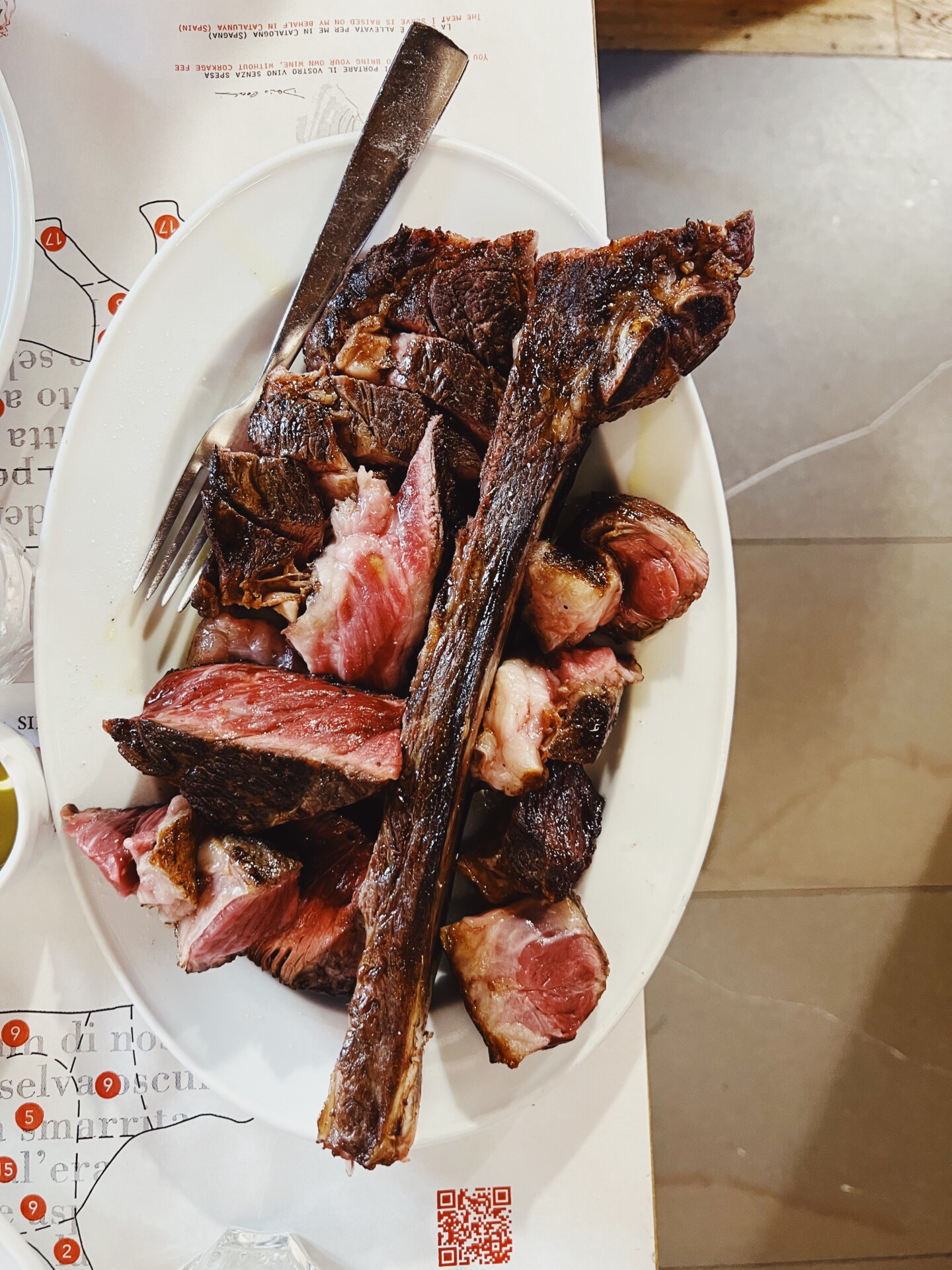
Antica Macelleria Cecchini
WHERE TO EAT BISTECCA ALLA FIORENTINA OUTSIDE THE CITY
Antica Macelleria Cecchini
You know and love him from Chef’s Table; we know and love him because he’s been a proponent of whole-animal cooking in Tuscany for decades. “I defend the last artisan butchers for whom the cooking method depends on the animal,” butcher Dario Cecchini affirms when we ask him about his bistecca alla Fiorentina. “Not salted, not oiled, not marinated,” the steak is cooked on the embers of holm oak wood fire “so that the grill leaves its shadow on both sides.” It’s then left to rest for five minutes on a wooden cutting board. Cecchini explains that simplicity is key–all that’s left is a grill master (of which he has many under his employ!) and a nice glass of red wine. “Primitive food, meat, and fire, and nothing else. True nourishment,” Cecchini finishes. We generally prefer the Solociccia restaurant, but if you’re a meat fanatic, head to the Griglieria Panzanese, where you’ll find a broader range of meat cuts.
Ristorante da Padellina
A 30-minute drive out of the city in the hills of Chianti, this restaurant is one of our all-time favorites–not just for the impressive steaks, but for the penne sul gallo, zuccotto, and cheerful owner who has a penchant for reciting verses from Dante’s Divine Comedy, which he knows by heart (!). Here, the bistecca is as rustic as it gets, hacked into thick slices tableside with a massive cleaver–hardcore. Pair with the perfect potatoes, sit in the big room downstairs or on the terrace with views of the hills, and you’ve got a perfect Sunday lunch.
Trattoria Bar Bibo
In the tiny town of Traversa, just a stone’s throw from the Emilia-Romagnan border, the wood-paneled Trattoria Bar Bibo is one of the most charming spots to snag a bistecca. Perfectly cooked–crispy-burnt on the outside and raw on the inside–the steak is cut into Goldilocks slices, not too thick and not too thin, with big flakes of salt to finish. We also love the knife-cut tartare, simple and unadorned so that the flavor of the meat really shines through. If you happen to be driving from Florence to Bologna (or vice versa), Bar Bibo makes the perfect meal stop, just a short detour from the A1.
Ristorante Tullio a Montebeni
One of our favorite restaurants in Florence, this spot is in Montebeni, just past Fiesole: you could even walk here if you were so inclined; the climb is steep, but the reward is well worth it! Tullio is a must for the spaghetti cavalieri, tortelli alla mugellana, and the untraditional bistecca–cooked over wood, oak, and olive wood and more marbled than others you’ll find, for it’s not made with Chianina (gasp!). “It’s not a meat I love to work with,” says Domenico of the classic cattle (which he’s only ever used “maybe once, 30 years ago”). Instead, he opts for meat from the Prussian or Limousin breeds: “We have five suppliers who send me videos of the loins they receive, and from there, I make my selection. I am possessive about my steaks—I choose, cut, and cook them myself.”
Domenico also counters the hyper-traditional when it comes to seasoning: “My grandmother taught me, back in ’58 when she opened, to salt it on both sides first. Despite claims that this may toughen the meat, I disagree. After 50 years of preparing it this way, I have the evidence. If the meat is of good quality and you know how to cook it, the salt doesn’t harden it; it actually enhances the flavor. Our uniqueness lies in using coarse salt and black pepper. Near the rib, where the fat is, it dissolves.” Delivered to the table with even more salt, pepper, and fennel seeds–on the side for you to use to your liking–the result is one of the most flavorful steaks we’ve ever tried and one that is beloved by Florentines, many of whom have standing reservations for primetime weekend spots. “Working exclusively with a Florentine clientele, we always have to be ready and prepared to serve this dish perfectly.”
(BONUS: If you’re looking for a real variation on the theme, spring for their bistecca fritta, steak floured, dipped in egg, and deep fried until crispy on the outside and still raw on the inside.)


